
Week of March 17, 1947
Youth Center Director
Cheescake,Genetics, and Martha Graham
I was very fortunate to find a set of bound volumes of LIFE Magazine for the year 1947. Since 2004 is just beginning, I thought that it would be appropriate to meander through 1947 one week at a time to see how things have (and haven't) changed in 57 years. By the way -- the bound volumes came from the library of Bridgewater College (in Bridgewater, Virginia...) Can anyone tell us more about this august institution?
We would LOVE to hear from you if you have some observations,ccomments or direct personal experience with any of the subjects treated here. Contact us by clicking here.
Click here to see excerpts from other LIFE magazine issues during 1947
Thanks to Google Books, you can click here to read the entire March 17, 1947 issue of LIFE Magzine. You can look at some of the images that we refer to but cannot post due to copyright.
The March 17 issue was adorned by a photo of cute little Betty Wagner of Coral Gables, Florida. At age 15, Betty was one of 13 Directors of the center that was built instead of a war memorial. The far-sighted vets in Coral Gables believed that they had fought WWII for their children and thought that the next generation would be their best memorial. Not only that, they had the good taste to hire Raymond Loewy to design it! Betty played basketball, danced and attended modeling classes at the Center and worried about keeping her ankles seady in high heels. She expressed a desire to go to College. Well, there certainly was a lot of Cheesecake in the article about the youth center...
The marquee article was a ten page treatise on genetics which even back then was a hot topic. DNA had not yet been discovered, but there was still plenty of controversy, particularly in the creation of new agricultural varieties of plants and animals. This was big business even back then.
Very prophetically, LIFE wrote: "...geneticists hope that some day their science will be devoted to the improvement of Man. When it is, the responsibility will be too great for geneticists alone, since the principal problem will be how to decide which characteristics of man should be eliminated and which should be preserved." And, we would add, the responsibility is also much too great for the Reverend Billy-Bob and his ilk.
There was a lot of "gene theory" around, but LIFE admitted that in 1947, "no one had ever seen a gene", although one theory held that genes make partial replicas of themselves which engineer the chemical reactions of life. This theory turned out to be not only true, but the centerpiece of the OJ Simpson trial.
Science was on the way, however. Already, some scientists were mapping the chromosomes of the fruit fly and they had learned that exposure to x-rays could produce mutations. This, of course led to the spate of giant animal films spawned by the atomic tests in the desert. Beginning with Giant Ants (Them), Hollywood eventually created giant spiders, giant rabbits, giant alligators, giant squid and even a 50-foot woman. By combining fear of pesticides with fear of atomic energy, they were able to conjure up The Incredible Shrinking Man. The Japanese created Godzilla, the ultimate real-estate stomping/fire-breathing genetic mutation. All of this may be of small comfort to those of you who may have bet your 401-K on genetic technology firms in the 1990s "bubble"
The British finally threw in the towel and withdrew from Greece, leaving the Civil War hanging precariously in the balance. Unless the US took up the slack, Greece would fall to Communism and then Turkey. Meanwhile, the Russians stirred up trouble in Korea, raising the ominous threat of another two-front war, just at the same time that the American public wanted to settle down and relax after World War II. General George Marshall, newly a civilian as Secretary of State, was summoned bfor the newly Republican Congress to answer to a whole lot of criticism. Meanwhile, strategic planners had come to realize that there was no way to hold our own in Europe without Germany as an active ally. LIFE published a very threatening map that showed Europe from the Russian point of view; in fact, Europe was made to look like a minor appendage of the Soviet Union. This scared a lot of people. Meanwhile, a plebiscite in Greece showed 70% support for King George and the monarchy. The Greek King George was a cousin of the British King George. The US sent the aircraft carrier Franklin D. Roosevelt to wait off the coast of Athens for further orders. Meanwhile, the Russians began to apply tremendous pressure to Turkey for warm-water access to the Black sea by assuming control of the Bosporous.
This week, the Editorial called upon President Truman to enunciate a "clear and unambiguous foreign policy." There were so many conflicts springing up all over the world that LIFE tried out a new phrase, "A crypto-war situation." This did not last and was replaced by a phrase coined by Churchill, "The Cold War". Churchill was very good at inspiring the US to fight his battles.... Meanwhile, Secretary Marshall would go off to Moscow to see if skilled diplomacy could some how make up for our lack of tanks in Europe... "Peace lies not in compromising but in invigorating our historic politics" opined Mr. Luce.
Meanwhile, President Truman was busy charming Mexico. As you will remember from last week's issue, this was the first time that an American president had visited our Neighbor to the South. He began his visit with a totally unscheduled visit to the Ninos Heroes, or the six Mexican cadets who fought the Americans (under Winfireld Scott) at the Battle of Chapultapec. This was accepted as a sincere gesture of friendship. Before a crowd of 41,000 at the National Stadium, the President mispronounced Technochtitlan, the crowd laughed and an older woman was heard shouting "Everyone mispronounces it!" A newspaper even defended Truman for passing up a bullfight, citing the political power of the A.S.P.C.A. Mexico was apparently the only place where poor President Truman was experiencing a good press.
Hugh Trevor-Roper, the eminent British historian wrote a six-page article on the Last Days of Hitler. This story is very well-known, and this particular article was the basis for a film of the same name starring Alec Guiness. LIFE's treatment of Hitler began a theme that continued through the 1940s and 1950s -- that Hitler and his associates were crazed, drug-addicted maniacs, while the German population was largely innocent. Since we badly needed the Germans to counter the Russians, this theory provided the rationale for re-arming them --- see, all the "Bad, Crazy Germans" are gone and we can safely rearm the "Good Germans." I was a kid at this time, and I never could figure out how about 8-10 obvious nuts were able to get control of a big country -- a country full of people dumb enough to let that happen shouldn't be trusted with anything more dangerous than sharp sticks. But, I was in the minority.
Apparently, Oxford Dons shouldn't be trusted with anything more dangerous than a sharp stick, either. Trevor-Roper's scholarly reputation suffered a shattering reverse in April 1983, when he held the Regius Chair of Modern History at Oxford and had been created Lord Dacre of Glanton. He authenticated about 60 volumes said to be Hitler's diaries.The diaries were then sold by the German magazine Stern to The Times newspaper group in London. Only a few days later, however, he reversed himself, saying he had "misunderstood the nature of their procurement" and now doubted their authenticity. A month later, the German government said chemical testing proved they were fakes. In 1985, Konrad Kujau, a Stuttgart dealer in Nazi memorabilia from whom Stern obtained the documents, was convicted of fraud in the case.
You may recall the March 3 article on the union troubles of the MGM Lion. Well, Hollywood had some real live union troubles that were simmering just below the surface. Los Angeles was the scene of a mass trial for over 1200 workers who had been sujected to mass arrests for picketing. The courts were trying to try huge numbers of pickets in an auditorium. The case soon turned to pandemonium, and the government tried smaller groups. Eventually, the farce was to cost the city over $1 Million (like $20 Million today) with few convictions for anything. They did demonstrate the lengths that the studios were willing to go to fight the unions.
Senator Arthur Vandenberg of Michigan was given an entire page to deny that he was the least bit interested in running for president. He even signed the document. He said that he was not a candidate six times, but at the end dis allow that he would accept a spontaneous draft. And, he kept his word!. Internationalist Thomas Dewey slugged it out with isolationist Robert Taft for the 1948 Republican nomination. Dewey won the nomination but got blindsided by Harry Truman in the famous "Give 'em Hell" campaign. Briefly: Vandenberg was editor and publisher of the Grand Rapids Herald from 1906 to 1928, when he was appointed to fill a U.S. Senate vacancy. Before World War II he was generally considered an isolationist, but by 1945 his views on foreign affairs had changed, and he became one of the chief proponents of a bipartisan foreign policy. He served as U.S. delegate to the San Francisco United Nations Conference in 1945 and as a delegate to the General Assembly of the United Nations (1946). As chairman of the Senate Committee on Foreign Affairs (1947–49), Vandenberg was the leading proponent of bipartisan support for President Truman's foreign policy. He was instrumental in securing Senate approval of the Marshall Plan and the North Atlantic Treaty Organization.
On March 5, the Mayor of Johnstown, Pennsylvania requested that the city council "Demote the police Chief to Patrolman." They did. The Police chief walked up to the mayor and slugged him. LIFE's photographer caught the action. later, the mayor sued the Chief for assault. So much for rule of law.
LIFE got two authors to write on the subject of "City vs. Country", pitting the benefits of Urban Excitement against Rural Solitude. The urban author was Charles Jackson, who had just enjoyed phenomenal success with The Lost Weekend a tale of alcoholism and desperation. The rural author was Granville Hicks who had likewise had a bestseller in Small Town. Alas, neither of the "advantages" set forth in the article was that realistic. For example under "social life", the urban Jacksons lunched at "21" with other famous authors, while the Rural Mr. Hicks joined some of his pals around a cracker barrel that could have come right out of Norman Rockwell's mind. While the Jacksons dropped backstage to visit actor friends on opening night, Mr. Hicks sspent his nights with the Grafton (NY) volunteer fire department. The Jacksons took their children on a scenic ride on the Staten Island Ferry while the Hicks family went skiing in the snow covered Berkshires. And about 99% of Americans had a MUCH more boring life than either family.
Of the two, Mr. Hicks was the very unlikely leftist (out of the New England Thoreau tradition) who was to struggle mightily with the House Un-American Activities Committee. Maybe all the Rubes sitting around that cracker barrel were Commie Stooges!
About 40 column inches were devoted to a fellow named Boyce House whose schtick was tall tales about Texas. Like "Pass the Biscuits Pappy" O'Daniels, who was elected governor (1938-1940) and senator (1941-1947) because of his Teaxs Boasting, House was not actually born in Texas, hailing from Piggott, Arkansas. And, (Guess what..), House ran for elective office several times. He came close in a race for lieutenant governor, but was never elected to anything. This probably didn't matter at all, since House had sold more than 250,000 copies of a small volume called Tall Talk from Texas. Here are some samples:
- Texans are so proud of their state that they can't sleep at night
- Texas is the land where exaggerations are the truth
- In Texas, the oil lies so close to the ground that notices are posted "Men with peg legs keep out"
- In heaven, Texans are chained to the Pearly Gate to keep them from going back home
- Some of the grapefruit grown in the Lower Rio Grande Valley are so big that it only takes nine to make a dozen
- In one Texas town, people were so healthy that they hired a Yankee to shoot himself just so they could start a cemetary
Well, you never have to ask if someone is from Texas: If he is, he'll tell you right away, and if he isn't there's no use embarassing him. By the way,
At the Brightside Orphanage near Holyoke Massachustetts, all 150 boys got their hair cut on the same day each month. LIFE was there to watch barber Tony Giannetti perform the mass shearing. If you want to learn more about this particular institution, check out the biography of Eunice Legare. In 1947, due to the Depression, the War, Industrial accidents and general poverty, there were 150 fairly normal children in an orphanage! Today, the facility is still there but it is now called the Brightside Adoption Resource Center
There waqs a housing crisis. People had a hard time finding any housing at all and most of the time it was in small and cramped quarters. Many of the guys in college on the GI Bill were living in converted garages and attics. So, it was particularly apt that LIFE's Modern Living section should present a suite of lightweight, portable furniture that could serve many purposes. This included a small piano that only weighed 20 pounds. The goal was to show how this multipurpose furniture could make one room do the work of four. In addition to a sofa-bed, the following items were offered:
- A fake mantel and fireplace turned itself into a dining room table; four folding chairs, dishes and candelabra were hidden inside the thing
- A waterfall Credenza opened up to be a combination sink and stove
- A suitcase opened into a stroller for a child
- A living room screen turned into a bar
- A hassock fan doubled as a footstool
Of these, only the sleep sofa and hassock fan (see our Fans Page for an example) have survived.
LIFE travelled to Tokyo to chronicle a day in the life of a Geisha, or "agreeable art-girl" as it was translated during the occupation; the Geisha was likened to the "Powers Model", of whom we have written in past issues. (actually, gei means "art and sha means "person", so a better translation would be "Art Person" or "artist") The lady in question was called Peach Blossom and she was at the absolute top of the Flower and Willow World, something roughly equivalent to "Tokyo Cafe Society." This kind of thing resonated much more in the 1930s and 1940s when successful New York businessmen were often seen in public with VERY attractive young ladies who were not members of their family. Peach Bloosom was at the top of her game, and had the extra distinction of being a master of the samisen the three-string banjo that makes that tinky-tinky oriental music. In addition to her salary as a teacher for this instrument, she also served as a "Professional Guest", for which she received about $10 a night. (She also had a "trust fund" from a danna or "Sugar Daddy" who saw her regularly during the War). Times being tough, she had sold all but about 20 of her 300 Kimonos
Her day began with a hot bath at 9, lunch with some friends and another hot bath in the afternoon. After a brief nap, she dresses and visits an expensive restaurant where she entertains anywhere from 3 to 40 gentlemen by playing the Samisen, poring wine and chatting knowledgeably on subjects of current interest. This was the only place in Japanese society where a woman was able to match wits with a man. The Geisha was trained to show no emotion whatsoever, save with subtle eye movements. The party would break up at about 10 when most of the male guests were too drunk for any kind of conversation.
Her favorite Western actor is Charles Boyer, and she loved Gone With the Wind. Her goal was to own her own restaurant. That really doesn't sound very different than most Broadway Show Girls...
A regular feature was photo coverage of a celebrity party. This week, LIFE followed some San Francisco socialites to an "Abandoned Mansion" party. The house had been built in 1916 by Mrs. Harriet Pullman Carolan Schermerhorn at a cost of about $2.5 mil Named "Carolands" after Ms. Pullman's first husband, the house had zillions of (actually 95) rooms, its own race track and was staffed by 60 servants;at 65,000 square feet, it is the largest single family residence west of the Mississippi. It was built on 1000 acres of land on the highest hill in in Hillsborough, the ultra-fashionable San Francisco subiurb. When Mr. Carolan died in 1922, the house was abandoned and remained vacant for 25 years. The federal government actually did a study of purchasing the estate for use as a Western White House. In 1947, 1300 young professionals staged a charity benefit in the remaining hulk of the mansion which was supposed to be demolished and sold as 2 acre lots. The benefit brought forth a savior -- and then another, and today the thing is still standing How about that!
Theis week, LIFE profiled Martha Graham, the "priestess of Intellectual Ballet." And, they had a picture of Martha herself in one of her free-flowing sack dresses that eventually became her trademark and a cliche. In 1947, she was a red-hot newcomer to the world of Dance. LIFE said, "Ms Graham's dancing is to the field of Ballet what James Joyce's prose and Salvador Dali's surrealist canvases are to the fields of writing and painting". This, of course, was back in the days when Joyce and Dali were exotic and revolutionary and definitely not in the Syllabus of Art 101. The exaotic Ms. Graham was a native of Pittsburgh, and migrated to New York to pursue "The Dance", or "The Dahnce" as "Movement" snobs are wont to say. At this point, Ms. Graham was deeply involved in setting the poems of Emily Dickinson to the "Dahnce". needless to say, the teenagers weren't lining up at the Paramout to see her work. Eventually she got into Art 101 and Gene Krupa did not.
The fearured film of the week was The Beginning or the End, a semi-documentary about the Manhattan Project that created the Atomic Bomb. LIFE decided that the film was "pseudoscientific pop". This film is shown with some regularity on Turner Classic Movies, and current opinion is not much different than LIFE's review -- "a bad drama to begin with, inaccurate documentation deprives this movie of the authoritative quality which MGM claims for it." Strangely, the fil was remade with almost all its silly mistakes intact in the 1995 film Fat Man and Little Boy, up to and including the death of the Handsome Young All-American Scientist of radioctive poisoning.
Ads for the following films were run:
- There was a full page ad for The Late George Apley, and interesting and mildly amusing tale of midlife crisis that is not the least bit risque. You wouldn't think so from the ad, however which says, "Stop apologizing for sex, George Apley.. you didn't invent it!" In the film, the Apleys and their in-laws furnish delightful and incisive comedy and drama against which we see George's two children, a young man and a young woman, each of whom strives heroically to break away from the shackles of family and tradition: Eleanor manages to do so and makes a satisfactory life for herself, while John, who falls in love with a young woman who had the bad taste not even to be born in Boston, is crushed by his father and all his father stands for. The film stars Ronald Colman and Peggy Cummins.
- A half-page ad advertised It Happened on Fifth Avenue starring Don DeFore, Charlie Ruggles and Gale Storm. This is a charming "Christmas Film" that had the very bad misfortune to be released at about the same time as "Miracle on 34th Street." It is very hard to get, and is not at all available on DVD.
- There was another full page ad for The Red House starring Edward G. Robinson and Julie London. This film was getting the full LIFE magazine "treatment" with a special profile of Julie in the March 3 Issue; aslo, below is a letter to the editor about Julie, and we have found yet another photo of the lovely Ms. London for your consideration.
The inside cover was an ad for Cannon Towels that read, "Humor the man! He'll love towel rings - no folding no fuss, simply loop towels through." I had no idea that towel rings (as opposed to bars) were a masculine convention...
Philco had another ad for the Model 1201 "Record-in-a-slot" radio-phono combination. See our Radio Page for an explanation of how these things work.

Ad for the Model 46-1201
The Bea Friendly line made by the Edgewood Shoe Company showed happy teenagers in Saddle Oxfords, and said "Make it a Match with Friendly 'Sports' ! What man isn't held by flattery? Whose eyes aren't caught by the twins of his shoes on your feet? Mannish, matching 'Saddle Boys' by Friendly!" I think that this means that it is "OK" for girls to wear saddle oxfords.
For many years, the Magnolia Oil Company's symbol has been Pegasus, the flying Red Horse and drew the bulk of its oil from the giant "Vacuum" Oil Field in texasthat brought prominence to the company). After the Standard Oil of New York (SOCONY) merged with Magnolia in 1931, the company became "Sacony Vacuum Oil". Now, we know this company as ExxonMobil.

The Scocony-Vacuum Trademark
Pegasus the Flying Red Horse, beloved of children
The Socony-Vacuum Oil Company of Los Angeles hired Franklin Gurley to start making a whole line of vibrant decorative candles for them that would help use up paraffin, an otherwise discarded substance from oil refining. During the late 1930s and 1940s, these candles were sold at Woolworths and also at the famous department store, Macy’s. The candles came in all sorts of artistic shapes (Bunnies, Duckies, Pixies, Rabbits, etc.) and were sold under the brand name Tavern Candles.
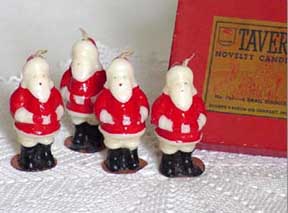
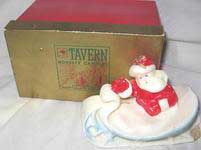
Tavern Candles and their Original Box
Gee, aren't they cute!
These candles are still beloved by Christmas collectors...this one has its original box and bottom label and is in amazing shape for a 1940's candle! Because they were so cute, most people didn’t want to burn them and ruin their appearance
Packard ran the first truly upscale car ad that we have seen in 1947. This was a classic of understatement. It featured four simple panesl under the title of "speaking of Red letter days.." Panel 1 shows a young boy finding his first bicycle under the Christmas tree; panel 2 Features that man in his 20s carrying his bride over the threshold. Panel 3 shows the man in his 30s viewing his newborn in the hospital. The fourth panel shows a mature, successful Dad showing off his brand new Packard to the Family. The last words are: "PACKARD Ask the man who owns one."
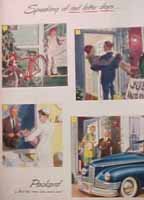
The Charming Packard Ad
Note that the Ivy has grown between panels 2 and 4
The Farnsworth Company was also advertising a very nicely styled table model television as well as a very luxurious chairside radio-phono. Check out our Vintage Television Page for much more interest in the Farnsworth company and Philo Farnsworth, its founder.
By the way, 1947 was sort of a watershed year for Television -- more and more cities were getting hooked up for TV, and by 1948, enough people had access to TV that the nominating conventions for both parties were televised. The major political effect of TV was not felt until 1952, however
The Cleveland Welding Company had an ad for the Roadmaster bicycle. More than that, the ad shows a kid in a COMPLETE COWBOY OUTFIT riding a Roadmaster Deluxe with tank, horn and sprung front forks. Check out our restoration of a competitor, the Coumbia Five Star Superb
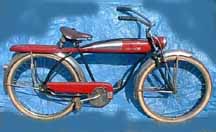
The Roadmaster Luxury Liner
This was truly a rich kid's bike!
Seven Up had a very nostalgic father-son ad showing Junior (wearing a beanie!) lookin approvingly while Dad paints a birdhouse that they have mad in the Family Workshop. "Do things together - Be a Fresh-up Family" read the copy. My guess is that there were exactly 4 Dads who actually did this, but there were about 70 million kids who wanted to meet tham.
A&P Markets were featuring Hot Cross Buns for Lent, sold under their famous Jane Parker label. The buns were to be delivered fresh daily throughout Lent which lasted from February 19 to April 6, 1947. Jane Parker? Wasn't she the one who who wrote Wuthering Heights? (A bonus two points if you can Tell me where that gag came from. The site of the last Jane Parker bakery is now a Upscale Housing development.
Ernie Harwell, sports editor of Leatherneck magazine visited Pete Petropoulous in a Veteran's Hospital and dropped off a carton of Chesterfields. Petropoulous, a star player for the Cardinals had been seriously wounded in the war and his ball playing days were over. The ad also announced that Petropoulos had been signed as a scout for the New York Giants
Record Ads: Columbia Records had a full-page ad for classical records, featuring Gregor Piatigorski, master of the violincello. In 1947, grammar dictated that this be abbreviated as: 'cello The apostrophe was dropped in the 1960s. RCA Victor ran a full page ad for Freddy Martin who had just released an album called "Concertos for Dancing." This was a collection of classical riffs and bits done up in swingtime. In the 1940s, "Swinging the Classics" was a popular way to mix the respectability of "serious music" with the youth appeal of swing. In the words of "Clinker" Krause (Keenan Wynn)in The Song of the Thin Man, this practice was strictly "off the cob." Meanwhile, Decca records had a full-page ad that asserted that "America is a Dancing land" and illustrated it with clever drawings of Square Dance, Rhumba, Ballroom, Ethnic dance and (of course) Swing dance. The square dance got the biggest picture.
Get the Girl Ads: Mennen Skin Bracer had a fairly provocative Gil Elvgren drawing of a cutie in bare midriff who said, "Your chances are beeter when you use Mennen Skin Bracer, its he-man aroma WOWS the ladies."
Ladies in Undergarments: Biflex Girdles showed a lady wearing one of their garments coyly flashing a fan. Their slogan was "The answer to a matron's flare." Stardust, maker of "insured slips" was having a beauty contest. All you had to do was send in a photo and height, weight and bust measurement. AND, there was one of those Pete Hartley Jantzen Girdle ads, that really pushed the edge of "permissibility"
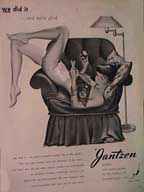
Jantzen Girdle Ad
Pete Hartley adding a little "zing" to the sales pitch
Mojud nylons had another peek-a-boo ad, while Peter Pan Bras had the first "Bullet Bra" ad that I have seen. These things are amazing - they make a sharp point that will take an eye out if you aren't careful.

The Peter Pan Bullet Bra
"The secret's in the circle"
Pictures of Babies: Empire Baby Pants was advertising waterproof pants made out of latex, the new wonder material.
Who was Endorsing Pens? The Inkograph pen (at $2) did not have an endorser but rather showed a lovely young lady writing in a journal as she rested against a tree. A babbling brook and small waterfall were nearby. The Inkograph was "as free flowing as a mountain stream." Inkograph made stylographic pens; they had a nib made from a hollow tube with a fine wire inside that moves up and down with pressure from the tip, allowing ink into the paper.
Retire on $150 a month? After a two month absence, the Phoenix Mutual was back with the tale of a 45 year old man who was laying back in a hammock dreaming about retirement day some 15 years hence. Apparently, he just couldn't save any money until he hit on the Phoenix Mutual's sure-fire plan. He says " When I reach 60 I can look forward to comfort and happiness as long as I live." Given the rate of inflation, it was probably merciful that the potential retiree was pictured as smoking.
A reader took issue with LIFE's review of the new film The Red House starring Julie London. The reader mentioned that the original novel by George Chamberlain was set in the pine barrens of New Jersey, but the film version is just set in an unidentified "wilderness". You will recall, that the February 24 Issue had a lengthy profile of star Julie London, and the March 3 issue had a full page ad for the film, as did the current issue.
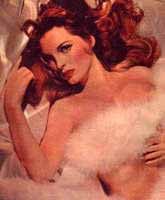
Julie London in a Boa
Just in case you have forgotten...
With regard to the "Bad German" story that showed Nazi doctors experimenting on allied prisoners, one of the soldiers who captured the photos wrote: "these pictures were found amid stacks of music by Mozart, Beethoven and others. If the doctor had survived he undoubtably would claim a place among the cultured..." [As a matter of fact, we were importing as many of those cultured men as we could so that they could make us bigger rockets than some of their cultured counterparts were making for the Soviets...]
Kurt Weill took issue with being called a "German Composer" in the February 24 review of his play "Street Scene". Weill wrote, " The Nazis did not consider me a German and I left in 1933 and am now an American citizen."
With respect to the debate about taking the Cable Cars out of San Francisco, a Texan wrote in saying that was as foolish as trying to take the Alamo out of San Antonio.
The back cover was another of those "More Doctors Smoke Camels" ads. This one had an unusual wrinkle -- during the War, cigarettes were in short supply, so people were forced to buy "less desirable brands" The ad suggested that any irritation that you might be experiencing was due to "cheap cigarettes" and your throat would get a whole lot better if you switched to Camels. These people were simply outrageous!
Counter for the Entire Site (not just this page..)
Home | About Lindy | 1940s Collectibles | Upcoming Events | Vintage Clothing
The Guide - Establishments - Travel - Accessories
Music | Links | Photo Gallery | Extras | Contact